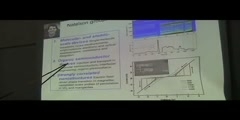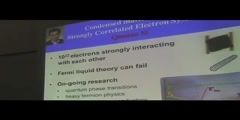Lec 20 - Spookytechnology and Society
"Lec 20 - Spookytechnology and Society" May 21, 2008 lecture by Dr. Charles Tahan for the Stanford University Computer Systems Colloquium (EE380). In this lecture, Dr. Charles Tahan gives a non-physics perspective on quantum information science and technology, both via some of his own scientific work, but mostly from the vantage of science and technology studies. He touches on why the new quantum revolution is for real, what "new quantum revolution" actually means, why it's more interesting than nanotechnology, and how we should prepare for it. EE380 | Computer Systems Colloquium: http://www.stanford.edu/class/ee380/ Stanford Computer Systems Laboratory: http://csl.stanford.edu/ Stanford Center for Professional Development: http://scpd.stanford.edu/ Stanford University: http://www.stanford.edu/ Stanford University channel on YouTube: http://www.youtube.com/stanford/
Video is embedded from external source so embedding is not available.
Video is embedded from external source so download is not available.
Channels: Computer Science
Tags: science electrical engineering math computer physics quantum mechanics information nanotechnology spookytechnology particle scale government hamiltonian society silicon condensed matter photon trap qubit
Uploaded by: stanfordcompsys ( Send Message ) on 03-09-2012.
Duration: 53m 39s
Here is the next lecture for this course
Lec 3 - TEDxCaltech - David Awschalom - S ...
10:11 | 5297 viewsChemical Science - Matter As a Wave - Lec ...
44:24 | 13862 viewsChemical Science - Particle-like Nature o ...
47:32 | 16464 viewsChemical Science-Atomic Theory of Matter ...
41:59 | 24361 viewsLec 7 - New Revolutions in Particle Physi ...
01:24:00 | 3549 viewsLec 2 - New Revolutions in Particle Physi ...
01:50:35 | 3193 viewsLec 3 - New Revolutions in Particle Physi ...
01:59:29 | 3086 viewsRice U Physics and Astronomy:Condensed Ma ...
06:49 | 5610 viewsRice U Physics and Astronomy: Condensed M ...
07:21 | 6108 viewsLec 1 - Genetic Engineering and Society, ...
51:43 | 3491 viewsLec 2 - Genetic Engineering and Society, ...
01:31:44 | 3034 viewsLec 3 - Genetic Engineering and Society, ...
28:40 | 2873 viewsLec 4 - Genetic Engineering and Society, ...
01:06:14 | 2567 viewsLec 1 - Modern Physics: Quantum Mechanics ...
01:51:11 | 3869 viewsLec 2 - Modern Physics: Quantum Mechanics ...
01:51:04 | 3174 viewsNo content is added to this lecture.
This video is a part of a lecture series from of stanford
Lecture list for this course
Lec 1 - The PeakStream Platform for Many-Core Computing
Lec 2 - Programmable Micofluidics
Lec 3 - Open Source Study: Analytics, Economics & Best Practices
Lec 4 - Self-Improving Artificial Intelligence
Lec 5 - The Challenges of Implementing Matlab®
Lec 6 - Parallel Programming 2.0
Lec 7 - On the Road to Computer Literacy
Lec 8 - Android: Building a Mobile Platform to Change the Industry
Lec 9 - Science Communication, Science Literacy and Public Support
Lec 10 - Tracking the Internet into the 21st Century
Lec 11 - Computing in Transition
Lec 12 - Scalable Parallel Programming with CUDA on Manycore GPUs
Lec 14 - CMOS Process Variations: A Critical Operation Point Hypothesis
Lec 15 - Demonstration of Brain Computer Interface Using the Emotive Epoc
Lec 16 - A Head in the Cloud: The Power of Infrastructure as a Service
Lec 17 - Distributed Systems: Computation With a Million Friends
Lec 18 - Dynamic Languages Strike Back
Lec 19 - The Challenge of Small Form Factor: The ASUS Eee PC
Lec 21 - The Search for Jim Gray
Lec 22 - The Role of Accelerated Computing in the Multi-Core Era
















